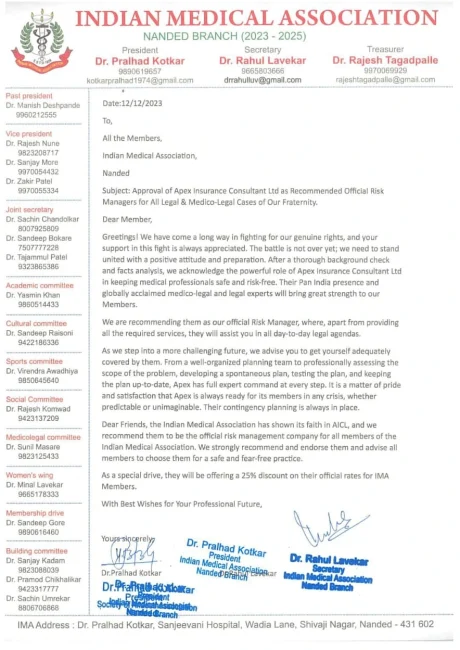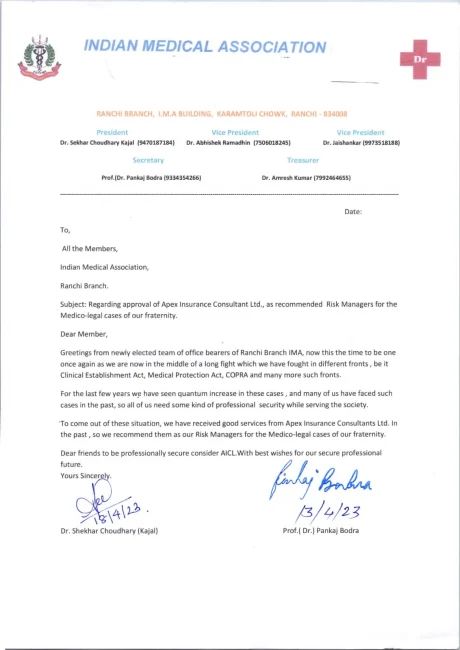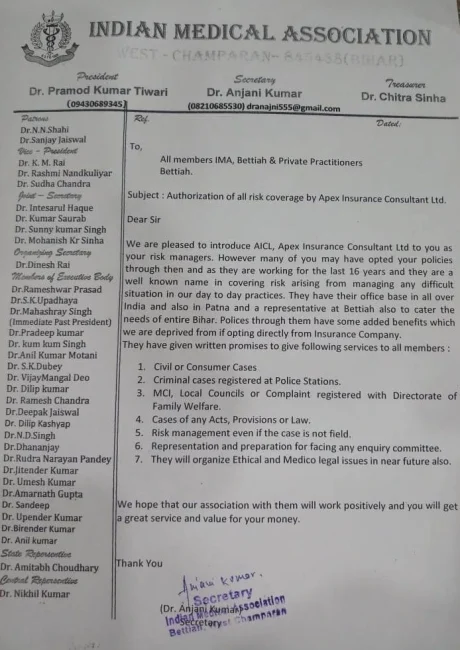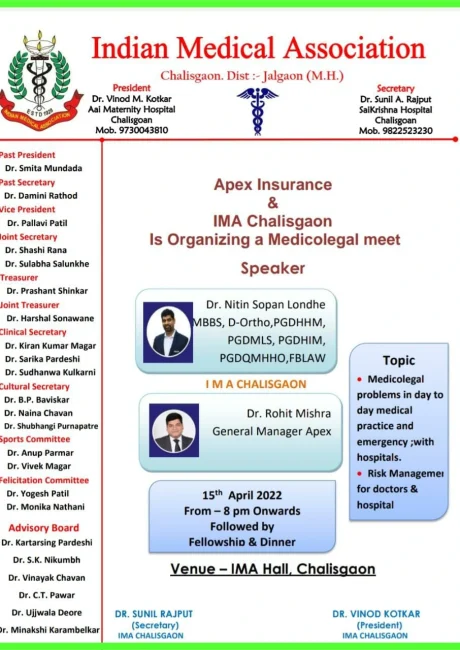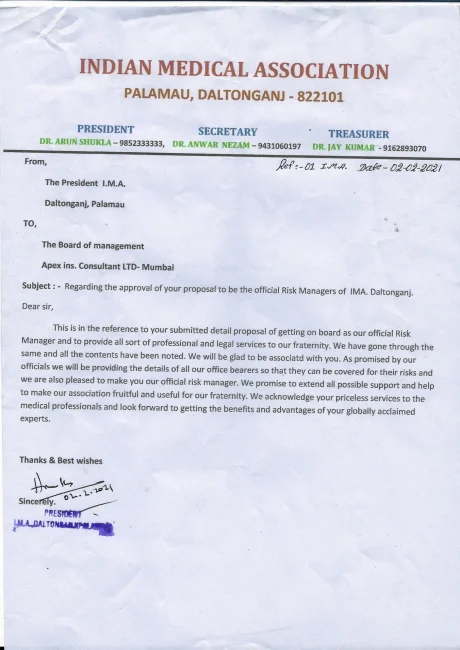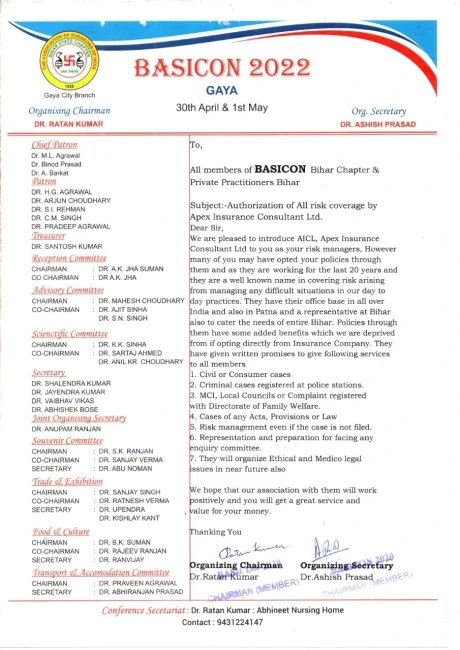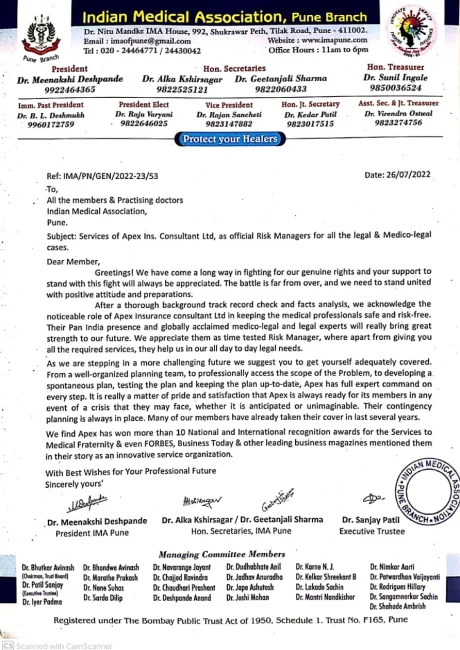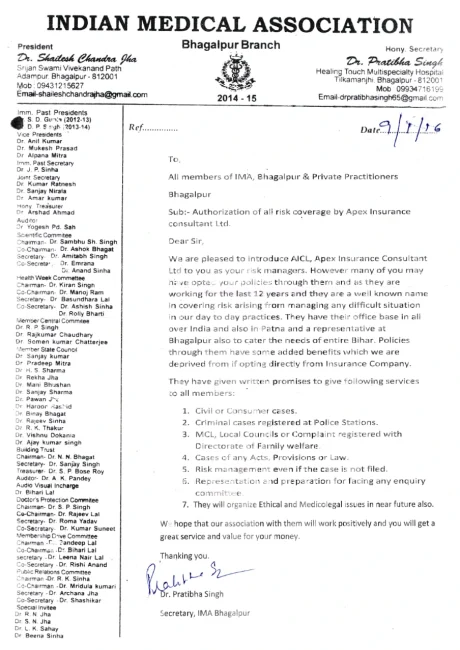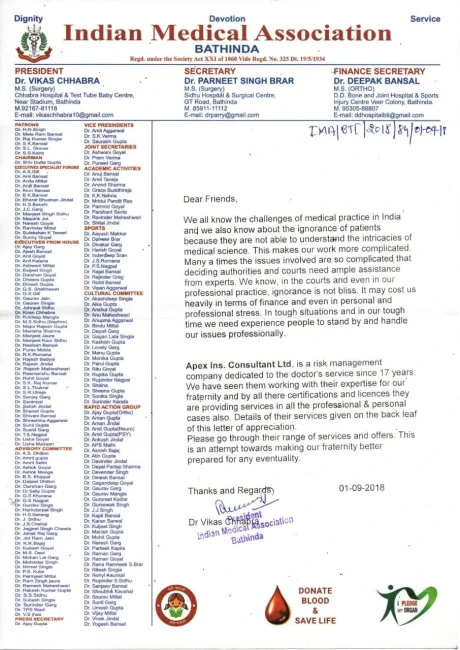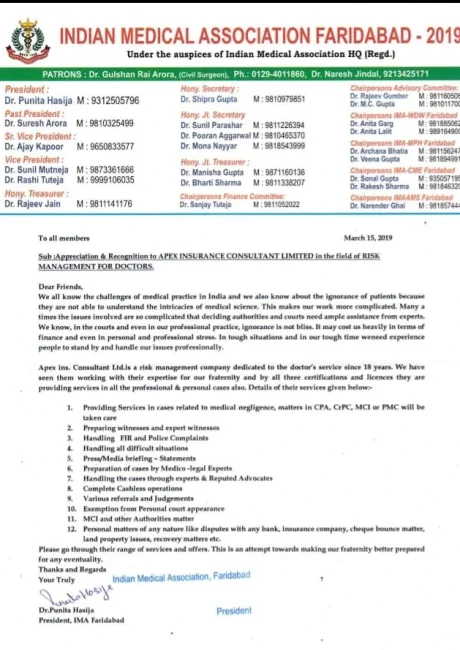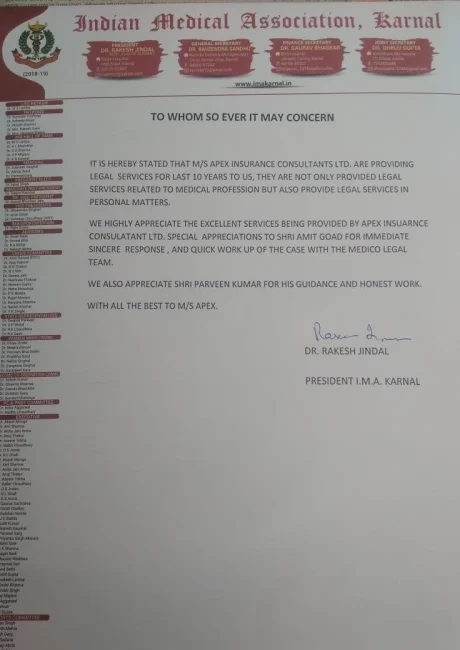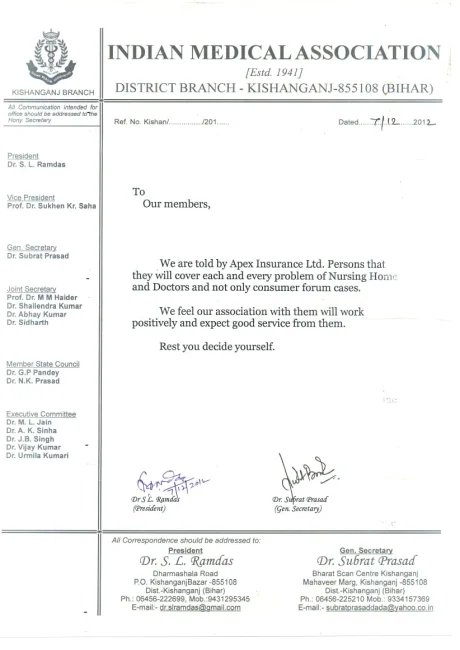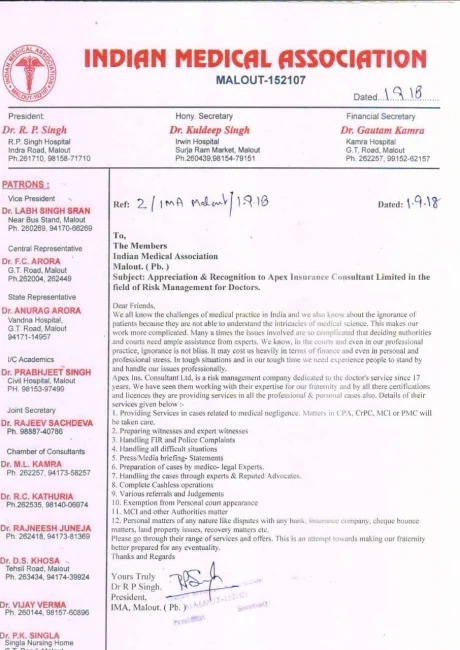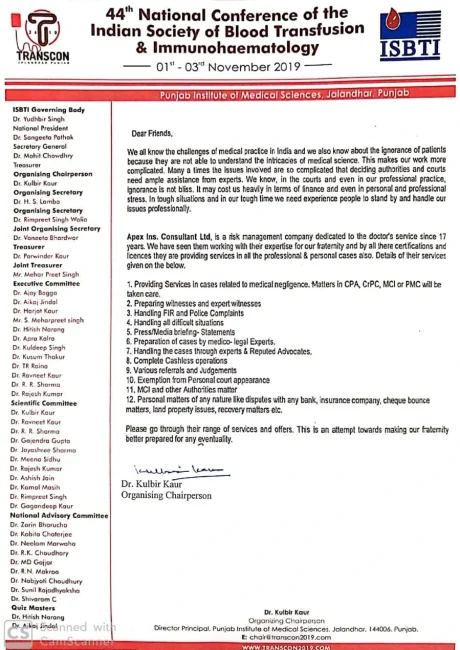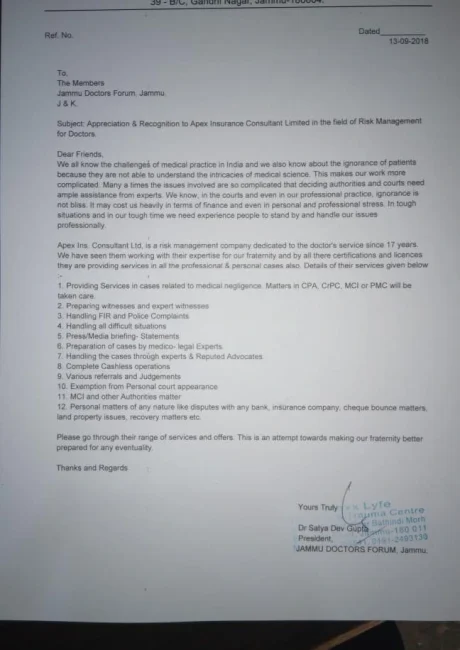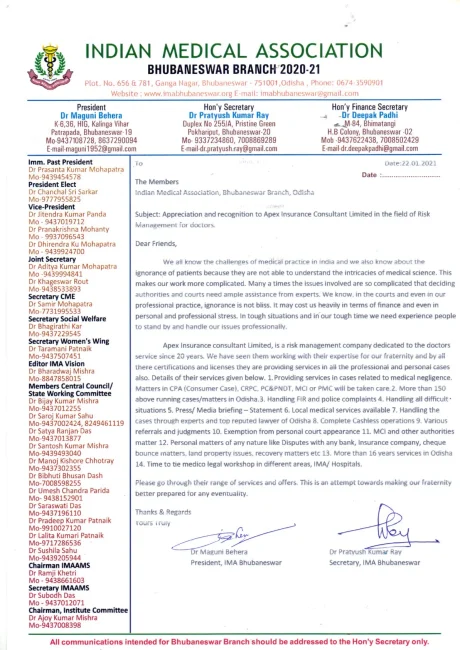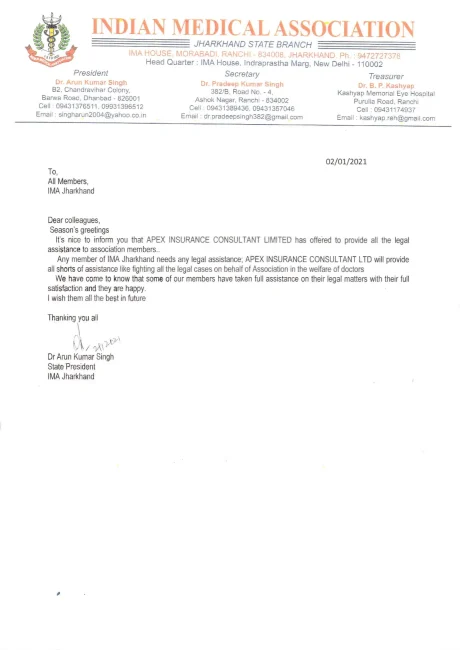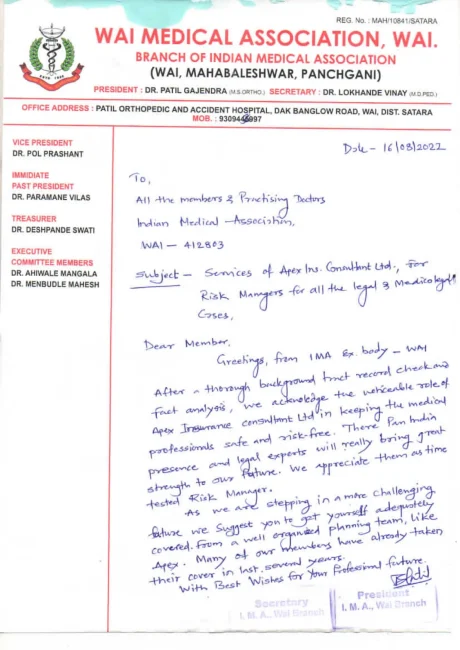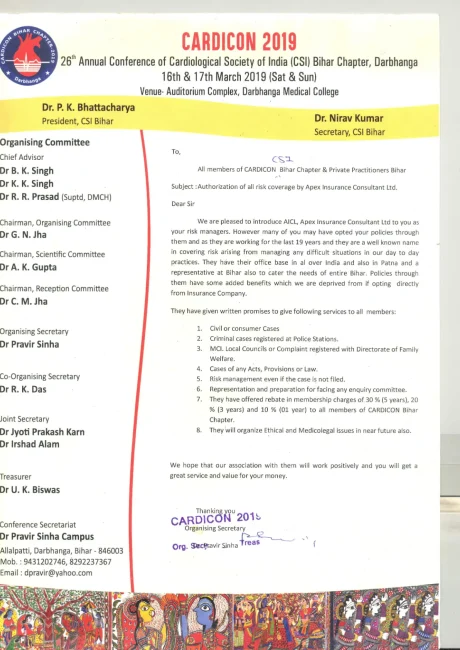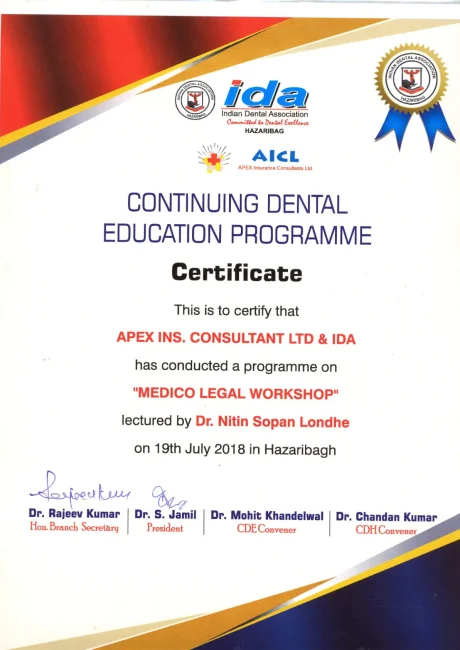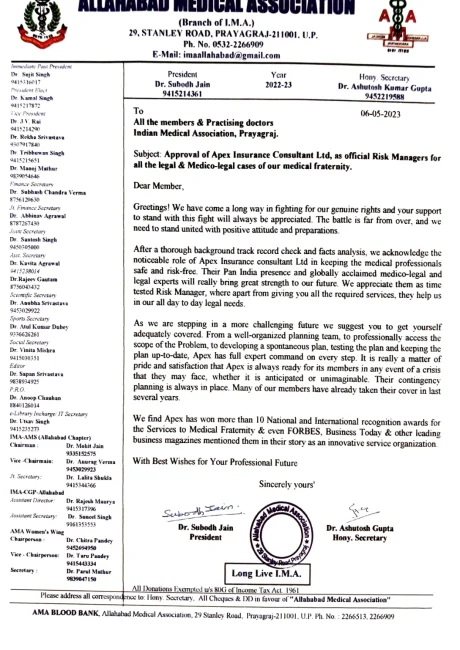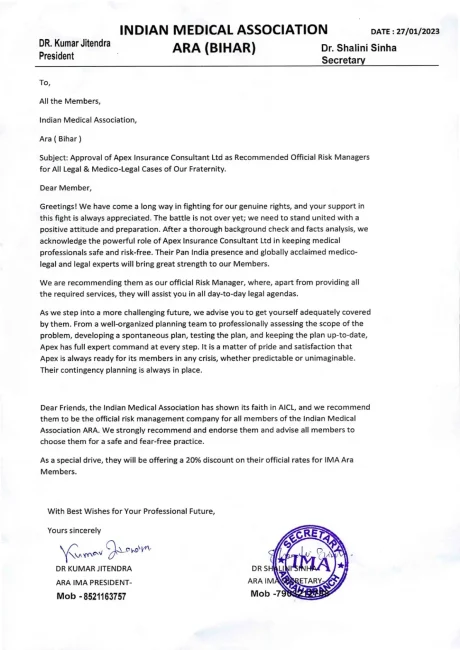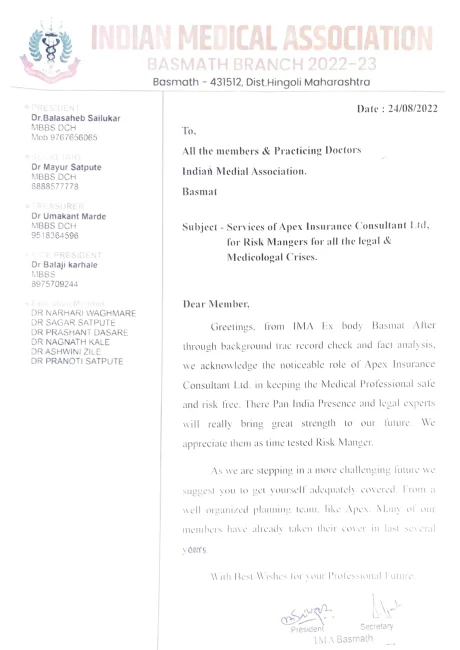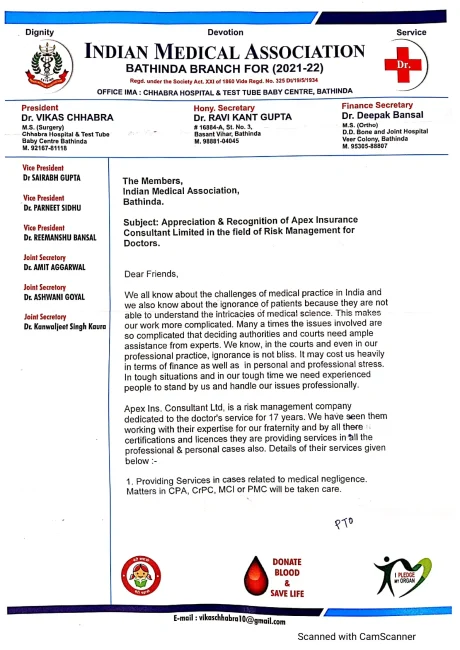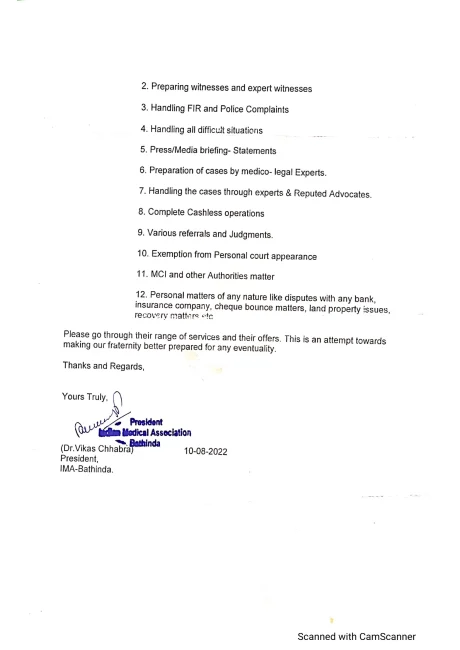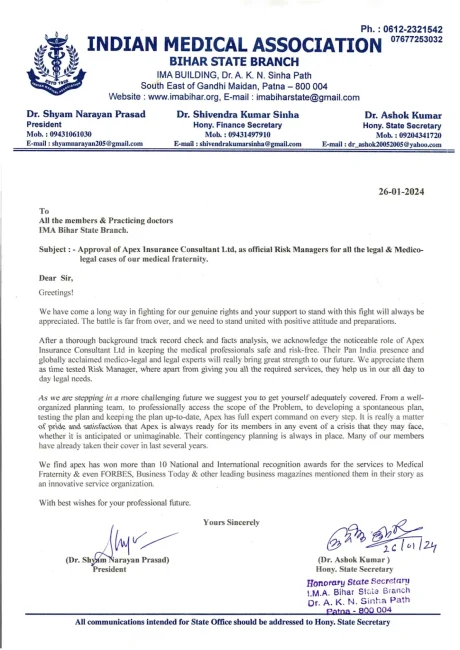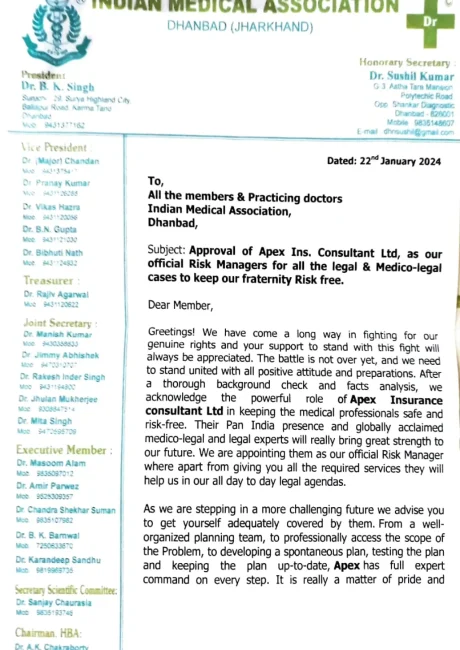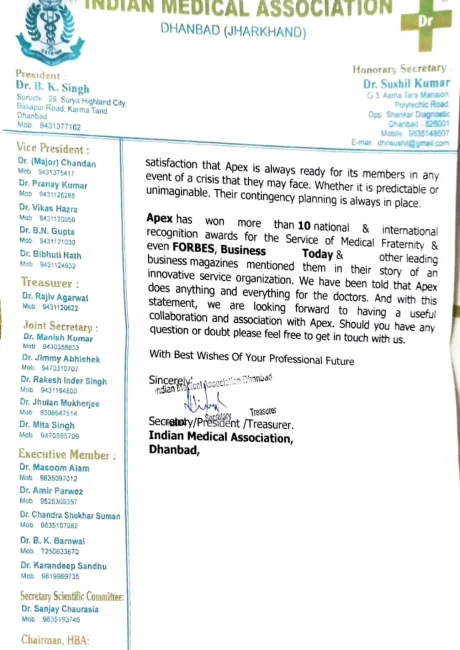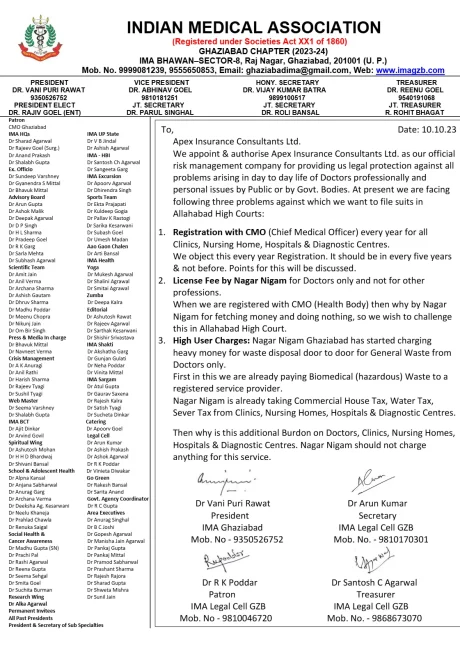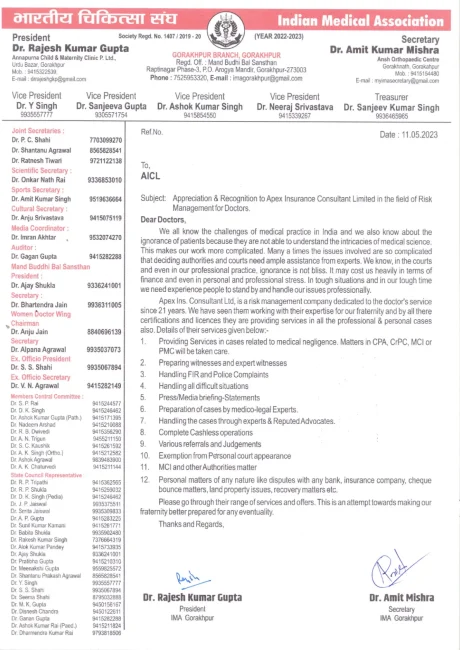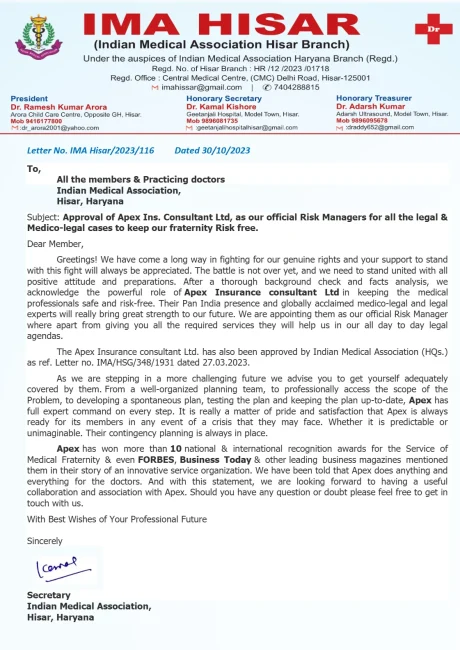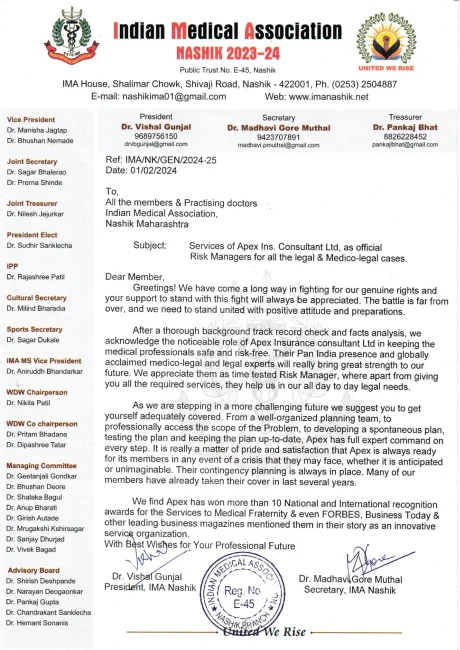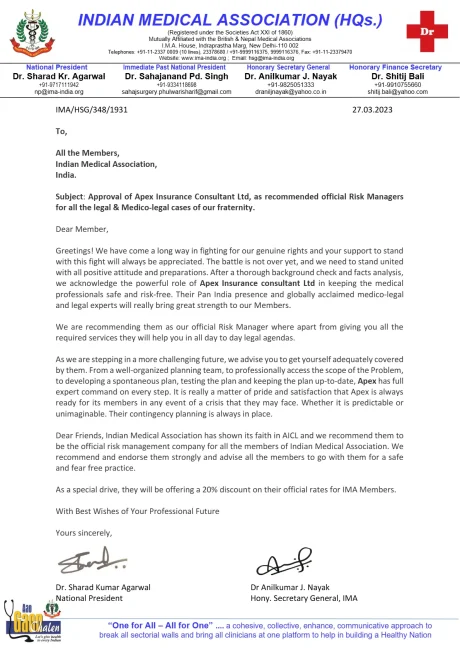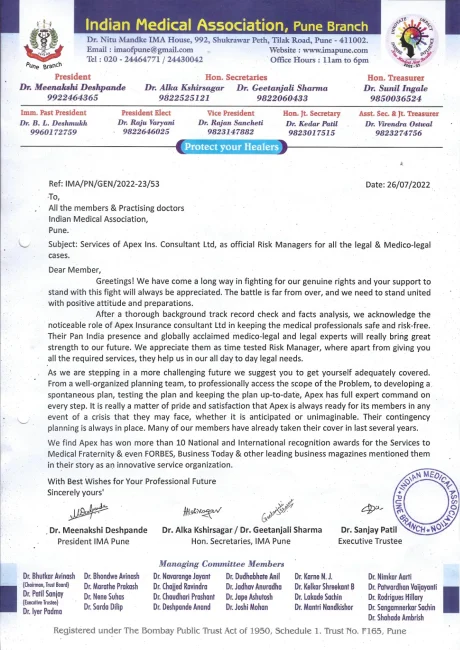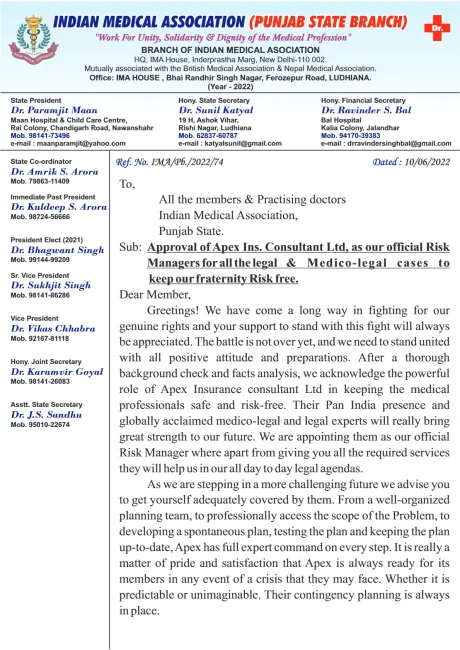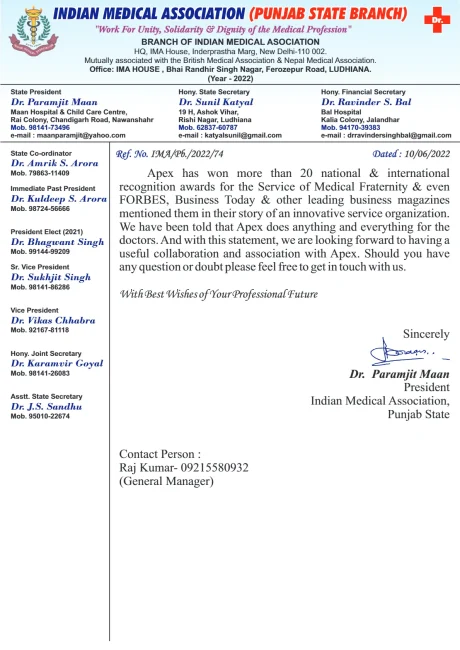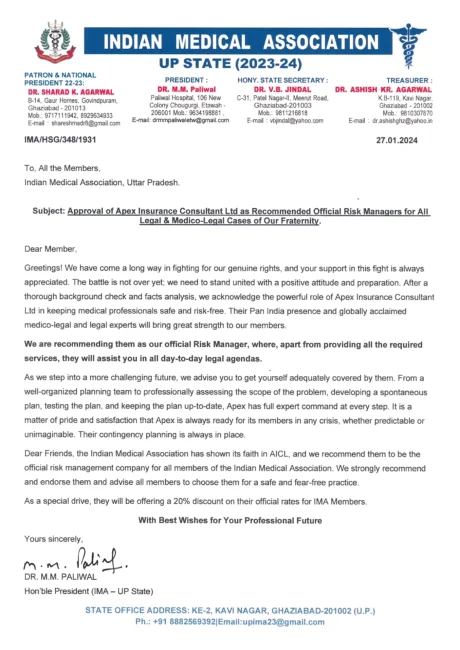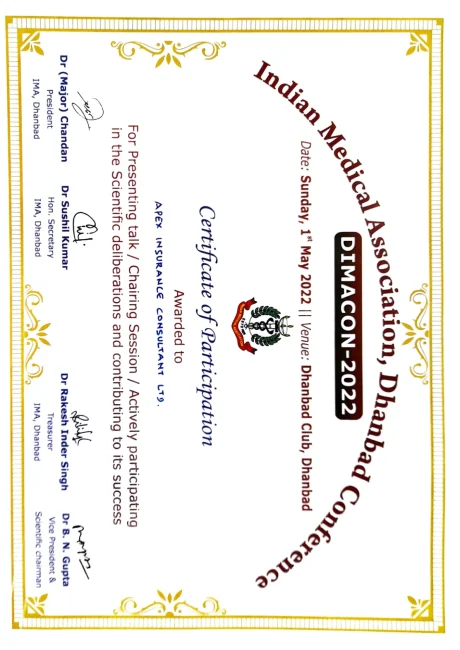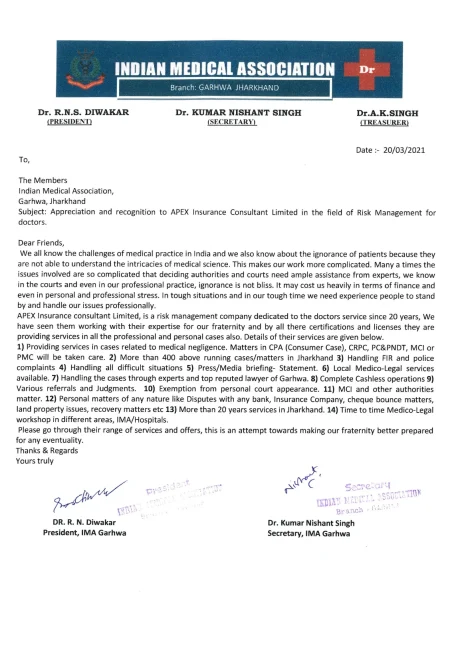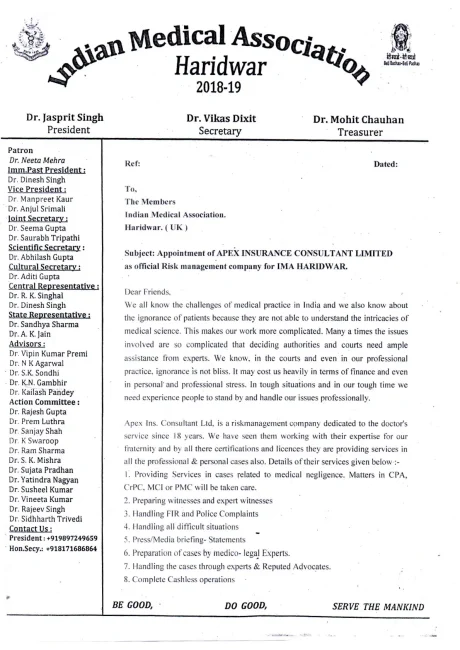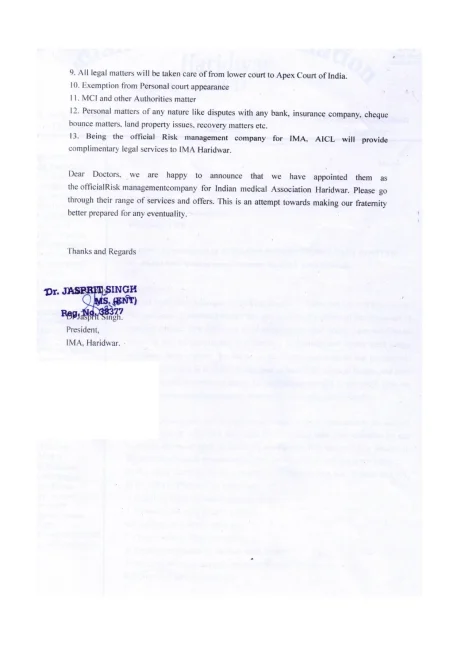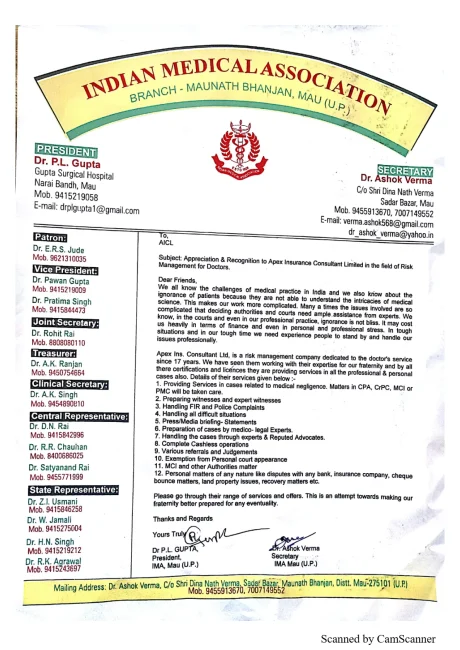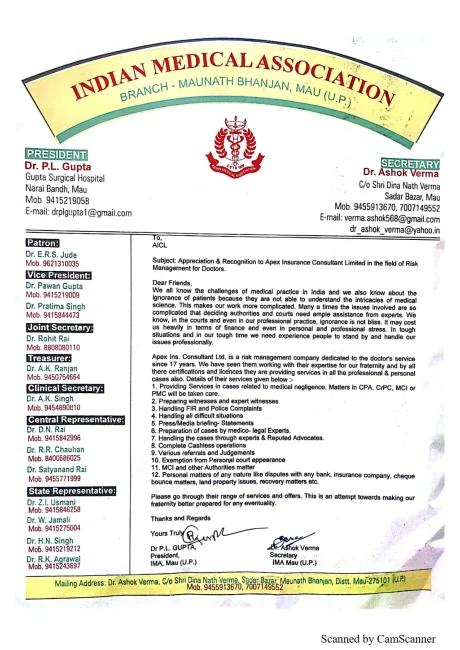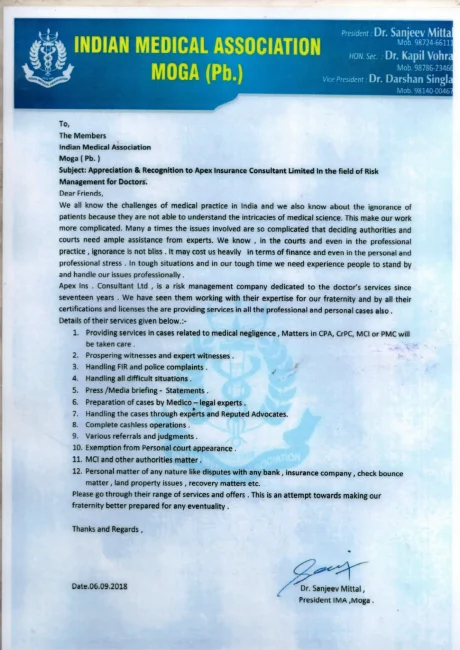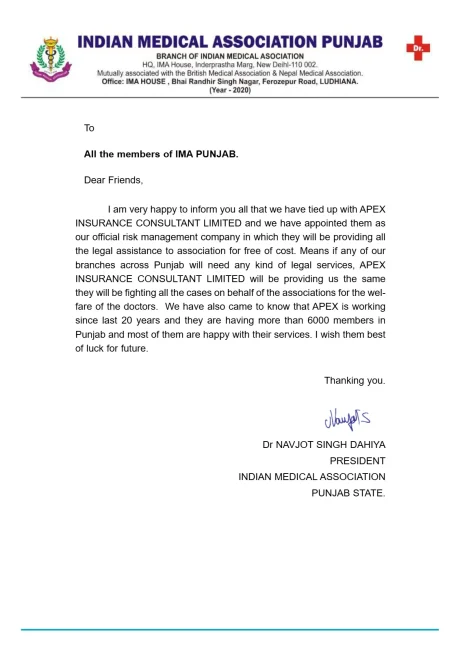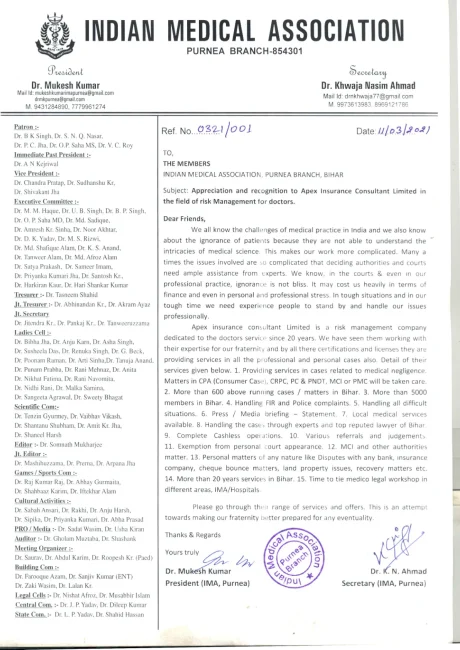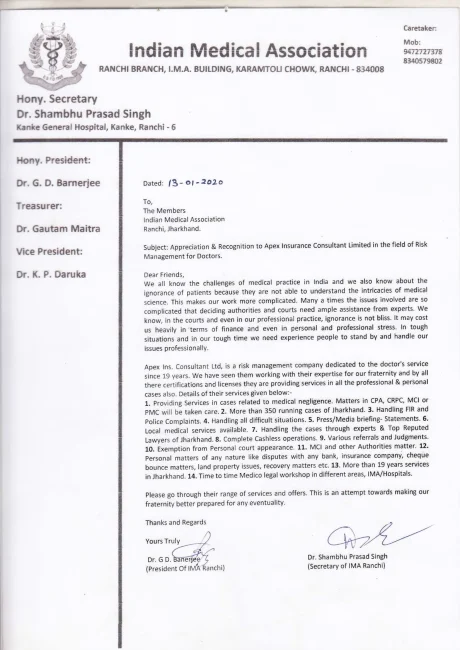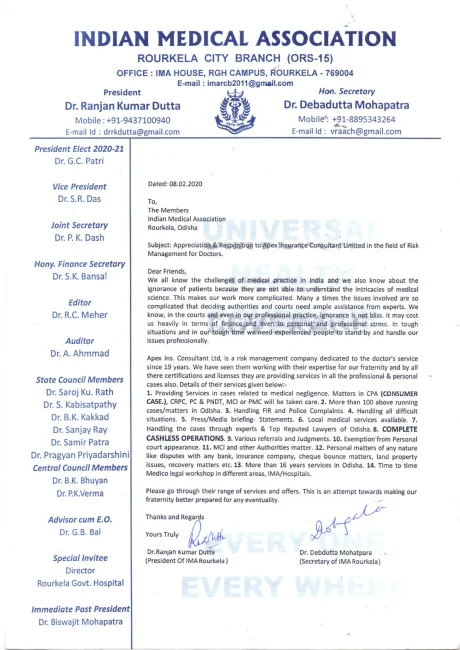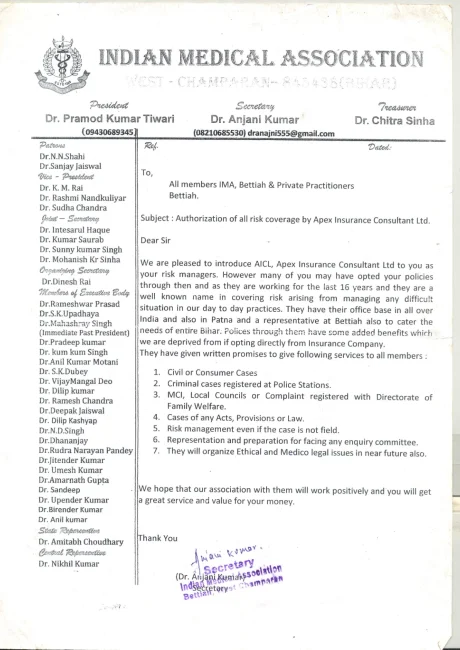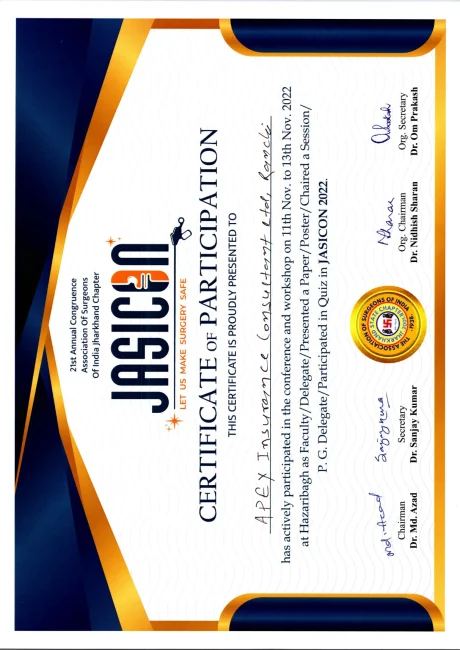By Dr. Mahesh Baldwa,
M.D,D.C.H,LL.B,LL.M , Ph. D(law)
MEDICOLEGAL SPECIALIST & ADVISOR
Formerly Assistant Professor of Pediatrics at T.N. Medical College and Nair Hospital, Mumbai-400008
Ex. Asst. Professor JJ Hosp, Grant medical college
Professor, paper setter & examiner of law to postgraduate students of University Department of Law, University of Mumbai
Baldwa Hospital, Sumer Nagar, S.V. Road,
Borivali (West)Mumbai 400 092
Introduction
The trust between the medical fraternity and the public is fast eroding. Factors responsible for such erosion are varied. Some of the obvious factors responsible are exorbitant cost of treatment, impersonal attitude of doctors.
Medical profession is full of risks
In various kinds of medical treatment and surgical operation, there is always a likelihood of an accident, complication or misfortune leading to death. Since death during medical treatment can’t be ruled out. A patient has to take willingly such a risk of death, even though it is a remote outcome. There is also a lack of awareness among the masses about such serious inherent risk, which leads them to take law in their hands or approach police for immediate action when some untoward incident takes place.
Common criminal substantive and procedural law
Criminal law is applicable to all individuals. Doctors are no exception to it. The procedural and evidence adducing aspects of civil and criminal law made them time consuming affair. Medical negligence litigation was being contested for years without an end in sight. Thus medical negligence litigation became a frustrating affair for both doctor as well as patient. In last decade doctor patient relationship has deteriorated and criminal complaints against doctors have increased by leaps and bounds.
Criminal law
Criminal law, one of two broad categories of law, deals with acts of intentional harm to individuals but which, in a larger sense, are offences against people at large. A crime is a deliberate or reckless act that causes harm to another person.
Civil law
Civil law deals with disputes between private parties, or negligent acts that cause harm to others . the failure to exercise the degree of caution that an ordinarily prudent person would take in any situation may result in a negligence claim. Depending on the circumstances, a person may be held responsible for any damages or injury that occurs as a result of their negligence. The party who brings the legal action is known as the plaintiff or applicant, while the party being sued is the defendant or respondent. The courts may dismiss a case, or if it is found to have merit, the courts may order the losing party to take corrective action, although the usual outcome is an order to pay damages – a monetary award designed to make up for the harm inflicted. The state plays no role in civil cases, unless the government launches a lawsuit or is the party being sued. Parties retain a lawyer – or may choose to represent themselves – to gather evidence and present the case in court.
Criminal negligence differentiated and defined by comparing it with civil law
Negligence is a term of art, but has distinct meanings in different jurisdictions. In ‘Tort’, damage is an essential ingredient but that element is not necessary in the law of master and servant. In criminal law, there are series of offences based on negligence in which loss or injury is not material; it is enough if the act is likely to cause injury or endanger life. Operation of patient without consent is an example of negligence (Statutory Damage) even without actual apparent damage. Dictionary meaning of term ‘Negligence’ is ‘Lack of Proper Care’. As defined by Baron Alderson negligence means: “Omission to do something which a reasonable man guided by those consideration which regulate conduct of human affairs would do, or doing something which a reasonable man would not do”. Same definition is quoted in many decisions of the court. ‘Criminal Negligence’ is an offence against the State while ‘Civil Negligence’ is an offence against the individual act, which leads to injury i.e. physical injury, hurt- Section 319, grievous hurt- Section 320 Indian Penal Code (IPC). Loss of property (financial loss) due to some negligent act is always a civil negligence.
More evidence is needed to find the accused at fault in criminal cases than to find the defendant at fault in civil ones. To convict someone of a crime, the prosecution must show there is proof beyond a reasonable doubt that the person committed the crime.
This gives the accused the benefit of any reasonable doubt and makes it less likely an innocent person will be wrongfully convicted and imprisoned. Civil cases, in contrast, must be proven on a balance of probabilities – if it is more likely than not that the defendant caused harm or loss, a court can uphold a civil claim. The complaints against doctors have increased(1). According to the provisions of Indian Penal Code 1860 (IPC) any act of commission or omission is not a crime unless it is accompanied by a guilty mind (MENS REA). The acts are not punishable only because it led to some mischievous results unless associated with intention or mental attitude of the person. Most of the times doctors treatment is in good faith, with the consent of the patient and hence most of the provisions of IPC are not applicable to the doctors unless or until there is rashness or gross negligence. The following Sections of IPC are related to medical profession (2):
Sec. 29 — documents-Described
Sec. 33. “Act”, “Omission”25
Sec. 34. Acts done by several persons in furtherance of common intention. 25
Sec. 52 — “Good faith” Described
Sec. 80 — occurrence of Accident in doing lawful act
Sec. 88 —Act not intended to cause death, done by consent in good faith for person’s benefit
Sec. 90 — Consent known to be given under fear or misconception
Sec. 114— Abettor present when offence is committed
Sec. 120A Definition of criminal conspiracy. 54. 51
Sec. 176 — Failure to inform police whenever essential.
Sec. 197. Issuing or signing false certificate
Sec. 201. Causing disappearance of evidence of offence, or giving false information to screen offender79
Sec. 202. Intentional omission to give information of offence by person bound to inform.. 79 Sec. 269-271 — Related to spread of infectious disease & disobedience of a Quarantine rule.
Sec. 272-273 — Related to adulteration of food & drinks.
Sec. 274-276 — Related to adulteration of drugs.
Sec. 304-A — Deals with death caused by a negligent act.
Sec. 306-309 — Are related with abatement of suicides.
Sec. 312-314 — Related to causing miscarriage, abortion & hiding such facts.
Sec. 315-316 — Deals with act to prevent child being born alive or to cause it to die after birth.
Sec. 319-328 — Are related to causing hurt, grievous hurt, loss of vision, loss of hearing or disfigurement by dangerous means.
Sec. 336-338 — Deals with causing hurt by rash or negligent act by dangerous means.
Sec. 340-342 — Are related to wrongful confinement.
Sec. 354. Assault or criminal force to woman with intent to outrage her modesty.
Sec. 376D. Intercourse by any member of the management or staff of a hospital with any woman in that hospital136
Sec. 405. Criminal breach of trust147
Sec. 406. Punishment for criminal breach of trust148
Sec. 415. Cheating. 150
Sec. 420. Cheating and dishonestly inducing delivery of property. 152
Sec.470. Forged document167
Sec.471 Using as genuine a forged document167
Sec. 499defamation.
Sec.504. Intentional insult with intent to provoke breach of the peace. 179
Sec.506. Punishment for criminal intimidation. 180
DIFFERENCE BETWEEN SECTIONS 304 & 304 – A:-
There is lot of discrepancy in application of above sections in cases of professional negligence by doctors. Most of the times, the police authorities register the cases of professional negligence causing death of a patient under sec. 304 of IPC. According to this section the offence is non-bailable. This causes lot of embarrassment, harassment, hardship, bad reputation & mental agony to the doctors. In fact the police are advised to register the cases of deaths of patients due to medical negligence under sec. 304 -A of IPC, in which the offence is bailable. The doctor can be released on bail under S. 304A by police authorities. Jacob Mathew (Dr.) v/s state of Punjab & Anr,III(2005) CPJ 9 (SC) Supreme court of India, In this judgment the judges observed in para 51 that the criminal process once initiated subjects the medical professional to serious embarrassment and sometimes harassment. He has to seek bail to escape arrest, which may or may not be granted to him. At the end he may be exonerated by acquittal or discharge but the loss which he has suffered in his reputation cannot be compensated by any standards.
The court held that, the legal position is almost firmly established that where a patient dies due to the negligent medical treatment of the doctor, the doctor can be made liable in civil law for paying compensation and damages in tort and at the same time, if the degree of negligence is so gross and his act was so reckless as to endanger the life of the patient, he would also be made criminally liable for offense under sec. 304-A IPC. Where, a patient’s death results merely from error or judgment or an accident, no criminal liability should be attached to it. Mere inadvertence or some degree of want of adequate care and caution might create civil liability but would not suffice to hold him criminally liable.
As per the judgment quoted below in V. Kishan Rao Versus Nikhil Super Speciality Hospital, the doctors cannot be arrested under criminal law without medical expert witness saying that there is criminal medical negligence on the part of treating doctor.
In another previous judgmentS C in C A NO. 3541 OF 2002, Martin F. D’Souza v Mohd. Ishfaqand Jacob Mathews Vs State of Punjab whichdirected that Courts/Consumer Fora as well as police should keep the above factors in mind when deciding cases related to medical negligence, and not take a view which would be in fact a disservice to the public.
We further warn the police officials not to arrest or harass doctors unless the facts clearly come within the parameters laid down in Jacob Mathew’s case, otherwise the policemen will themselves have to face legal action.
Procedural criminal law
The Code of Criminal Procedure [Cr PC] is the main legislation on procedure for administration of substantive criminal law in India.[3] It was enacted in 1973 and came into force on 1 April 1974.[4] It provides the machinery for the investigation of crime, apprehension of suspected criminals, collection of evidence, determination of guilt or innocence of the accused person and the determination of punishment of the guilty. The Act consists of 484 sections, 2 schedules and 56 forms. The sections are divided into 38 chapters.
Classification
Cognisable and non-cognisable offences
Cognisable offences are those offences for which a police officer may arrest without court mandated warrant in accordance with the first schedule of the code. For non-cognisable cases the police officer may arrest only after being duly authorised by a warrant. Non-cognisable offences are, generally, relatively less serious offences than cognisable ones.
Summons case and warrant case
Under Section 204 of the code, a Magistrate taking cognisance of an offence is to issue summons for the attendance of the accused if the case is a summons case. If the case appears to be a warrant case, he may issue a warrant or a summons as he sees fit. according to the section 2(w) those case are not warrant case are summon case and warrant case are those which lies to imprisonment of death, life and for more than two-year according to section 2(x).
Bailable and non-bailable
According to Section 2(a), bailable offence are offences listed under the First Schedule as bailable or made bailable under any other law for the time being in force. All other offences are non-bailable.
Territorial extent
The Criminal Procedure Code is applicable in the whole of India except in the State of Jammu and Kashmir. The Parliament’s power to legislate in respect of Jammu & Kashmir is curtailed by Article 370 of the Constitution of India.
Provisions under Chapters VIII, X and XI of the code do not apply to the State of Nagaland and some tribal areas in Assam. However the concerned State Government may, by notification apply any or all of these provisions in these areas. Moreover, the Supreme Court of India has also ruled that even in these areas, the authorities are to be governed by the substance of these rules.
Sentences which magistrate may pass
- The Court of a Chief Judicial Magistrate may pass any sentence authorized by law except a sentence of death or of imprisonment for life or of imprisonment for a term exceeding seven years.
- The Courts of Judicial Magistrate of First Class may pass a sentence of imprisonment for a term not exceeding three years, or of fine not exceeding five thousand rupees, or of both.
- The Courts of Judicial Magistrate of Second Class may pass a sentence of imprisonment for a term not exceeding one year, or of fine not exceeding one thousand rupees, or of both.
- The Court of a Chief Metropolitan Magistrate shall have the powers of the Court of a Chief Judicial Magistrate and that of a Metropolitan Magistrate, the powers of the Courts of Judicial Magistrate of First Class
Sentences which other judges of session court/ high and supreme court may pass
The above Courts may pass any sentence authorized by law
difference between civil law and criminal law
“The difference between civil law and criminal law turns on the difference between two different objects which law seeks to pursue – redress or punishment. The object of civil law is the redress of wrongs by compelling compensation or restitution: the wrongdoer is not punished; he only suffers so much harm as is necessary to make good the wrong he has done. The person who has suffered gets a definite benefit from the law, or at least he avoids a loss. On the other hand, in the case of crimes, the main object of the law is to punish the wrongdoer; to give him and others a strong inducement not to commit same or similar crimes, to reform him if possible and perhaps to satisfy the public sense that wrongdoing ought to meet with retribution.”
The lawyers almost always make money be it civil case or criminal one. That’s one thing both civil and criminal cases have in common.
| Civil Law | Criminal Law | |
| Definition | Civil law deals with the disputes between individuals, organizations, or between the two, in which compensation is awarded to the victim. | Criminal law is the body of law that deals with crime and the legal punishment of criminal offenses. |
| Purpose | To deal with the disputes between individuals, organizations, or between the two, in which compensation is awarded to the victim. | To maintain the stability of the state and society by punishing offenders and deterring them and others from offending. |
| Case filed by | Private party | Government |
| Decision | Defendant can be found liable or not liable, the judge decides this. | Defendant is convicted if guilty and acquitted if not guilty. |
| Standard of proof | “Preponderance of evidence.” Claimant must produce evidence beyond the balance of probabilities. | “Beyond a reasonable doubt”: |
| Burden of proof | Claimant must give proof however, the burden may shift to the defendant in situations of Res Ipsa Loquitur (The thing speaks for itself). | “Innocent until proven guilty”: The prosecution must prove defendant guilty. |
| Type of punishment | Compensation (usually financial/pecuniary) for injuries or damages, or an injunction in nuisance. | A guilty defendant is subject to Custodial (imprisonment) or Non-custodial punishment (fines or community service). In exceptional cases, the death penalty. |
| Appeals | Either party (claimant or defendant) can appeal a court’s decision. | Only the defendant may appeal a court’s verdict. The prosecution is not allowed to appeal. |
| Commencement of proceedings | Advocate notice State/People/Prosecution by summons or indictment | Advocate notice/FIR/police complaint By way of pleadings, Representatives of the state, Prosecutor, Attorney General. |
WHEN DOCTORS SHOULD INFORM POLICE:-
A doctor has to inform the police in following circumstances. Failure to inform police in such cases may result in penal consequences:-
Police mustbe informed in:-
- Cases of suspected homicide
- Cases of suicidal deaths
- Unknown, unconscious patient
- Death on operation table
- Suspected unnatural death
- Sudden, unexpected, violent & unexplained death
- Instant death after treatment or reaction of medicine
- Married lady dying within seven years of marriage due to any reason
It is advisable to inform police in following circumstances:-
- Undiagnosed death within 24 hrs. of admission or specially if there is any suspicion then it is desirable to inform the police about such deaths. If the cause of death can be ascertained or diagnosed by the treating doctor then there may not be any need to inform the police.
- Any cases of poisoning, tetanus, burns
- Accidental deaths
- In cases of hospital deaths if:- I) accidents not related to medical management like fall from stair-case etc., though there is no legal obligation on doctor, it is advisable to inform the police. ii) Unexpected or rare complications may occur sometimes eg. A child may vomit, aspirate the content & may die. This is very unpredictable & it is not obligatory on part of the doctor to inform such deaths. But it is better if we inform the police because sometimes patient’s relatives may allege negligence in such cases. iii) In cases of death due to negligence in treatment there are no specific provisions to inform the police but in order to avoid untoward incidences it is better to inform the police.
“Brought dead cases” :- in such cases, if the cause of death is apparent & there are no reasonable grounds to suspect some medico-legal complications then it is not necessary to inform the police.
If the cause of death can’t be ascertained in any case then it is desirable to send the body for postmortem examination preferably with the help of the police. It is advisable to suggest postmortem in the following circumstances:-
- Whenever death is sudden, unexpected or unexplained
- Accidental deaths which may be roadside, domestic or industrial
- When precise cause of death is needed for insurance claim purposes etc.
- As a help to arrive at final diagnosis
Information to police shall preferably be in writing & the proper written acknowledgement should be obtained. If the information is telephonic one must note down name, buckle number & designation of the police.
in criminal medical negligence cases, Medical expert witness is a must
Supreme court in V. Kishan Rao Versus Nikhil Super Speciality Hospital, CIVIL APPEAL NO.2641_ OF 2010 decided on March 8, 2010
That The test of medical negligence which was laid down in Bolam vs. Friern Hospital Management Committee reported in 1957 (2) All England Law Reports 118, has been accepted by this Court as laying down correct tests in cases of medical negligence. Bolam was suffering from mental illness of the depressive type and was advised by the Doctor attached to the defendants’ Hospital to undergo electro-convulsive therapy. Prior to the treatment Bolam signed a form of consent to the treatment but was not warned of the risk of fracture involved. Even though the risk was very small and on the first occasion when the treatment was given Bolam did not sustain any fracture but when the treatment was repeated for the second time he sustained fractures. No relaxant drugs or manual control were used except that a male nurse stood on each side of the treatment couch throughout the treatment. About this treatment there were two bodies of opinion, one of which favoured the use of relaxant drugs or manual control as a general practice, and the other opinion was for the use of drug that was attended by mortality risks and confined the use of relaxant drugs only to cases where there are particular reasons for their use and Bolam case was not under that category. On these facts the expert opinion of Dr. J.de Bastarrechea, consultant psychiatrist attached to the Hospital was taken. Ultimately the Court held the Doctors were not negligent. In this context the following principles have been laid down: “A Doctor is not guilty of negligence if he has acted in accordance with a practice accepted as proper by a responsible body of medical men skilled in that particular art” It is also held that in the realm of diagnosis and treatment there is ample scope for genuine difference of opinion and a doctor is not negligent merely because his conclusion differs from that of other professional men. It was also made clear that the true test for establishing negligence in diagnosis or treatment on the part of a doctor is whether he has been proved to be guilty of such failure as no doctor of ordinary skill would be guilty of if acting with. Even though Bolam test was accepted by this Court as providing the standard norms in cases of medical negligence, in the country of its origin, it is questioned on various grounds. It has been found that the inherent danger in Bolam test is that if the Courts defer too readily to expert evidence medical standards would obviously decline. Michael Jones in his treaties on Medical Negligence (Sweet & Maxwell), Fourth Edition, 2008 criticized the Bolam test as it opts for the lowest common denominator. The learned author noted that opinion was gaining ground in England that Bolam test should be restricted to those cases where an adverse result follows a course of treatment which has been intentional and has been shown to benefit other patients previously. This should not be extended to certain types of medical accident merely on the basis of how common they are. It is felt “to do this would set us on the slippery slope of excusing carelessness when it happens often enough” (See Michael Jones on Medical Negligence paragraph 3-039 at page 246). With the coming into effect of Human Rights Act, 1988 from 2nd October, 2009 in England, the State’s obligations under the European Convention on Human Rights (ECHR) are justiciable in the domestic courts of England. Article 2 of the Human Rights Act 1998 reads as under:- “Everyone’s right to life shall be protected by law. No one shall be deprived of his life intentionally save in the execution of a sentence of a court following his conviction of a crime for which this penalty is provided by law”. Even though Bolam test ‘has not been uprooted’ it has come under some criticism as has been noted in Jackson & Powell on Professional Negligence (Sweet & Maxwell), Fifth Edition, 2002. The learned authors have noted (See paragraph 7-047 at page 200 in Jackson & Powell) that there is an argument to the effect that Bolam test is inconsistent with the right to life unless the domestic courts construe that the requirement to take reasonable care is equivalent with the requirement of making adequate provision for medical care. In the context of such jurisprudential thinking in England, time has come for this Court also to reconsider the parameters set down in Bolam test as a guide to decide cases on medical negligence and specially in view of Article 21 of our Constitution which encompasses within its guarantee, a right to medical treatment and medical care. In England, Bolam test is now considered merely a ‘rule of practice or of evidence. It is not a rule of law’
(See paragraph 1.60 in Clinical Negligence by Michael Powers QC, Nigel Harris and Anthony Barton, 4th Edition, Tottel Publishing). However as in the largerBench of this Court in Jacob Mathew vs. State ofPunjab and another – (2005) 6 SCC 1, Chief JusticeLahoti has accepted Bolam test as correctly laying down the standards for judging cases of medical negligence, we follow the same and refuse to depart from it.The question of medical negligence came up before
this Court in a decision in Mathew (supra), in the context of Section 304-A of Indian Penal Code. Chief Justice Lahoti, speaking for the unanimous three-Judge Bench in Mathew (supra), made a clear distinction between degree of negligence in criminal law and civil law where normally liability for damages is fastened. His Lordship held that to constitute negligence in criminal law the essential ingredient of ‘mens rea’ cannot be excluded and in doing so, His Lordship relied in the speech of Lord Diplock in R. vs. Lawrence, [(1981) 1 All ER 974]. The learned Chief Justice further opined that in order to pronounce on criminal negligence it has to be established that the rashness was of such a degree as to amount to taking a hazard in which injury was most likely imminent. The neat formulation by Lord Atkin in Andrews v. Director of Public Prosecutions, [(1937) 2 All ER 552 (HL) at page 556] wherein the learned Law Lord delineated the concept of negligence in civil and criminal law differently was accepted by this Court. Lord Atkin explained the shades of distinction between the two very elegantly and which is excerpted below:- “Simple lack of care such as will constitute civil liability is not enough. For purposes of the criminal law there are degrees of negligence, and a very high degree of negligence is required to be proved before the felony is established.” Chief Justice Lahoti also relied on the speech of Lord Porter in Riddell vs. Reid [(1943) AC 1 (HL)] to further identify the difference between the two concepts and which I quote:- “A higher degree of negligence has always been demanded in order to establish a criminal offence than is sufficient to create civil liability.” [This has been quoted in the treatise on Negligence by Charlesworth and Percy (para 1.13)] In the concluding part of the judgment in Mathew (supra) in paragraph 48, sub-paras (5) and (6) the learned Chief Justice summed up as follows:- “(5) The jurisprudential concept of negligence differs in civil and criminal law. What may be negligence in civil law may not necessarily be negligence in criminal law. For negligence to amount to an offence, the element of mens rea must be shown to exist. For an act to amount to criminal negligence, the degree of negligence should be much higher i.e. gross or of a very high degree. Negligence which is neither gross nor of a higher degree may provide a ground for action in civil law but cannot form the basis for prosecution. (6) The word “gross” has not been used in Section 304-A IPC, yet it is settled that in criminal law negligence or recklessness, to be so held, must be of such a high degree as to be “gross”. The expression “rash or negligent act” as occurring in Section 304-A IPC has to be read as qualified by the word “grossly”.” After laying down the law, as above, the learned Chief Justice opined that in cases of criminal negligence where a private complaint of negligence against a doctor is filed and before the investigating officer proceeds against the doctor accused of rash and negligent act, the investigating officer must obtain an independent and competent medical opinion preferably from a doctor in Government service, qualified in that branch of medical practice. Such a doctor is expected to give an impartial and unbiased opinion applying the primary test to the facts collected in the course of investigation. Hon’ble Chief Justice suggested that some statutory rules and statutory instructions incorporating certain guidelines should be issued by the Government of India or the State Government in consultation with the Medical Council of India in this regard. Till that is done, the aforesaid course should be followed. But those directions in paragraph 52 of Mathew (supra) were certainly not given in respect of complaints filed before the Consumer For a under the said Act where medical negligence is treated as civil liability for payment of damages. This fundamental distinction pointed out by the learned Chief Justice in the unanimous three-Judge Bench decision in Mathew (supra) was unfortunately not followed in the subsequent two-Judge Bench of this Court in Martin F. D’souza v. Mohd. Ishfaq, reported in 2009 (3) SCC 1. From the facts noted in paragraphs 17 and 18 of the judgment in D’souza (supra), it is clear that in D’souza (supra) complaint was filed before the National Consumer Disputes Redressal Commission and no criminal complaint was filed. The Bench in D’souza (supra) noted the previous three-Judge Bench judgment in Mathew (supra) [paragraph 41 at pages 17-18 of the report] but in paragraph 106 of its judgment, D’souza (supra) equated a criminal complaint against a doctor or hospital with a complaint against a doctor before the Consumer Fora and gave the following directions covering cases before both. Those directions are set out below:- “We, therefore, direct that whenever a complaint is received against a doctor or hospital by the Consumer Fora (whether District, State or National) or by the criminal court then before issuing notice to the doctor or hospital against whom the complaint was made the Consumer Forum or the criminal court should first refer the matter to a competent doctor or committee of doctors, specialised in the field relating to which the medical negligence is attributed, and only after that doctor or committee reports that there is a prima facie case of medical negligence should notice be then issued to the doctor/hospital concerned. This is necessary to avoid harassment to doctors who may not be ultimately found to be negligent. We further warn the police officials not to arrest or harass doctors unless the facts clearly come within the parameters laid down in Jacob Mathew case, otherwise the policemen will themselves have to face legal action.” We are of the view that aforesaid directions are not consistent with the law laid down by the larger Bench in Mathew (supra). In Mathew (supra), the direction for consulting the opinion of another doctor before proceeding with criminal investigation was confined only in cases of criminal complaint and not in respect of cases before the Consumer Fora. The reason why the larger Bench in Mathew (supra) did not equate the two is obvious in view of the jurisprudential and conceptual difference between cases of negligence in civil and criminal matter. This has been elaborately discussed in Mathew (supra). This distinction has been accepted in the judgment of this Court in Malay Kumar Ganguly (supra) (See paras 133 and 180 at pages 274 and 284 of the report). Therefore, the general directions in paragraph 106 in D’souza (supra), quoted above are, with great respect, inconsistent with the directions given in paragraph 52 in Mathew (supra) which is a larger Bench decision. Those directions in D’souza (supra) are also inconsistent with the principles laid down in another three-Judge Bench of this Court rendered in Indian Medical Association (supra) wherein a three-Judge Bench of this Court, on an exhaustive analysis of the various provisions of the Act, held that the definition of ‘service’ under Section 2(1)(o) of the Act has to be understood on broad parameters and it cannot exclude service rendered by a medical practitioner. This shows the importance of medical expert witness is a must in criminal medical negligence cases.
CAN A DOCTOR BE ARRESTED?
- Doctors have no immunity against arrest for the various criminal acts as per the provisions of IPC or Criminal procedure code of India.
- One reads about arrest of doctor dealing in illegal organ trading, unlawful sex-determination etc. which are non-bailable offenses.
- If patient or his relations feel that there has been criminal negligence in treating causing simple / grievous injury / death, he may file a First information Report (F.I.R.) or non-cognizable (N.C.) in the police station.
- Usually non-cognizable (NC) offence a complaint has to be filed in the court of Judicial Magistrate having jurisdiction, police will not take any further initiative in such cases after registering NC.
- Where the police are reluctant or refuse to register the F.I.R. in a cognizable case. Similar procedure is for filing a complaint may be adopted even in a case of cognizable offence
- Cognizable offences are usually serious in nature and in which police has power to arrest without warrant. In case of a non-cognizable offence, the arrest can be made only after the Magistrate issues a warrant.
- If death is caused, the case is usually registered under section 304A IPC.
- For grievous injury caused by surgery case may be registered under section 337, 338 IPC
- All these above-said three offences are, no doubt, cognizable (in which police can arrest the doctor without warrant) but at the same time bailable.
Bail
- Above-stated offences for which doctors are charged are bailable.
- The police is under legal obligation to inform the doctor for the grounds / reason of arrest under section 50(2) Cr. PC
- Doctor is entitled to be released on bail at the police level itself. Police has power to release the doctor on execution a Personal Release bond of Rs 1500/=
- Police may ask higher amount sureties then in such event doctor may arrange for the other sureties of reasonable amount as per police procedure.
- Once doctor furnishes the required sureties, the doctor has a right to be released on bail at once by the police itself.
- At the time of arrest the doctor has a right to be told with full particulars of the offence for which he is being arrested or other ground for such arrest.
- In case the doctor is unable to arrange for the sureties, the police is legally bound to produce him before the nearest Magistrate within 24 hours of his arrest excluding the time required for journey from the place of arrest to the Magistrate under S. 167 of Cr.PC
- If the doctor is able to arrange for the sureties by that time he shall be released on bail either by the police itself or by orders of the Magistrate. As the provisio says that the doctor’s professional is essential and emergency service.
- If any person is directly arrested then police has to inform their family members also.
Anticipatory bail
- When there is likelihood of a criminal complaint being filed against a doctor he can apply for anticipatory bail so as to avoid arrest by the police
- Section 438(1) of Cr PCconfers on the High Court and the court of sessions the power to grant anticipatory bail if the applicant has reason to believe that he may be arrested on the accusation of having committed “a non-bail able offence”.
- If the offence is non-bailable, it is immaterial for the purpose of section 438 whether the offence is cognizable or non-cognizable, or whether it is one under the Indian Penal Code or under any other law. (MTP or PNDT or BMW Act)
- Even with apprehension of arrest also the anticipatory bail can asked even when offence which is not registered with the police.
- Anticipatory bail can be asked when summons are issued u/s 161 of Cr. PC by the police for investigation and interrogations
- The filing of FIR is not a condition precedent to the exercise of the power under section 438.
- The imminence of a likely arrest founded on a reasonable belief can be shown to exist even if an FIR is not yet filed.
Reference:-
- Tiwari SK, Baldwa M. Medical Negligence. Indian Pediatr 2001; 38: 488-495.
- Joshi MK. Doctor and Medical Law. 2nd edition, Ahmedabad, 1995, pp 4-6.
- Bharti, Dalbir (2005). The Constitution and criminal justice administration. APH Publishing. p. 320.
- Jump up Menon, N. R. Madhava; Banerjea, D; West Bengal National University of Juridical Sciences (2005). Criminal Justice India Series: pts. 1-2. Chandigarh. Allied Publishers. p. 229.

